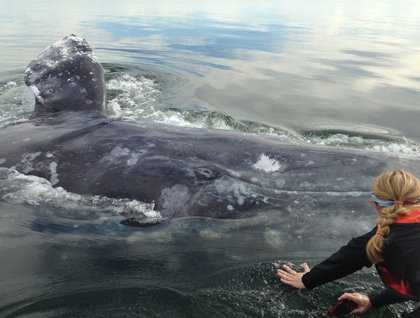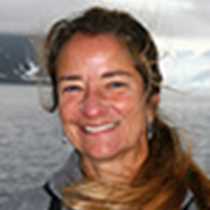We had spent the night anchored in a narrow section of Magdalena Bay, surrounded by miles of sand dunes and mangroves. As night changed to day, I heard a whale exhaling; in the dim twilight a gray whale mother and calf were swimming beneath Jupiter. Sunrise turned the sky a brilliant orange-red.
We boarded small expedition landing crafts to view gray whales in this narrow section of the bay. Several mother-calf pairs swam slowly or just rested in shallow water to the north and south of our ship. A whale calf swam from one side of its mother to the other, at times sliding off her huge back. When the whales swam close to us, their massive size was apparent—the mothers were twice as long as our small boats. Sometimes when we looked down into the water, instead of green water, we saw yellowish-white and mottled gray transform into bodies, flippers and flukes of whales as they rose to surface. We were sprinkled with tiny droplets of salt water when they exhaled. Some hands were able to reach out and touch soft, smooth whale skin. Certain whales approached our boats, circling around and swimming beneath us repeatedly. Young calves were dark gray, and they often turned on their sides, one eye above the water. We had wonderful encounters with the whales, and perfect conditions of calm, glassy water.
Our trusted pilot Alejandro came aboard and guided the National Geographic Sea Bird through the narrow and shifting channel he has marked with buoys. Along the way, we sighted a coyote walking on the shore, and countless wading shorebirds: egrets, herons, and ibises. We enjoyed lunch on the sundeck as we traveled south in Hull Canal.
At La Entrada, the main entrance to Magdalena Bay, a few gray whales were among numerous small fishing boats. Swells of the open Pacific Ocean gently rolled the ship. We will be traveling towards the southern tip of the Baja California peninsula all night.







